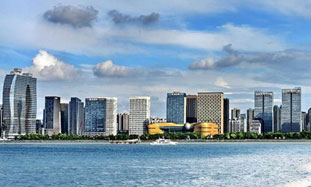Hangzhou Hi-Tech Industrial Development Zone
The Hangzhou Hi-Tech Industrial Development Zone (HHTZ) was founded in March 1990, and ratified as a state-level hi-tech zone by the State Council in March 1991. In 2002, HHTZ was integrated with Binjiang district of Zhangzhou, which was established in 1996. HHTZ (Binjiang) has a total area of 92 square kilometers.
The 11.4-square-kilometer section on the north bank of the Qiantang River borders many higher education institutions and scientific research units, and is an innovation source for high and new technology and an incubator of small and medium sized science and technology enterprises. The 73-square-kilometer section on the south bank of the Qiantang River has been Hangzhou's city sub-center and a technology town. The 8-square-kilometer section to the east of the Qiantang River was established in 2009 as a science park. In 2014, HHTZ (Binjiang) had a population of 181,000.
HHTZ (Binjiang) has five major advantages. First, it enjoys an innovative administrative system. As a state-level hi-tech industrial development zone, HHTZ enjoys the state's special preferential policies and simplified administrative approval procedures.
Second, HHTZ boasts an excellent location. HHTZ (Binjiang) is only 15 kilometers from Hangzhou Xiaoshan International Airport, and borders Shanghai-Hangzhou-Ningbo Expressway. HHIDZ (Binjiang) has become an important strategic area for sharing common prosperity along the Qiantang River in Hangzhou.
Third, HHTZ attracts a galaxy of talents. It has established a long-term and friendly cooperative relationship with higher educational institutions like Zhejiang University, and scientific research institutes like the Chinese Academy of Sciences, helping to develop high and new technology industries with technical support and high quality talents. In 2014, 21,200 highly skilled individuals were introduced to the zone.
HHTZ (Binjiang) has become a hotbed of innovations and business start-ups. It now has a group of listed enterprises established by domestic companies such as Hangzhou Silan Microelectronics. A group of high and new technology enterprises founded by returned talents countrywide, such as Utstarcom, the leading communication technology company, have also settled in the zone.
Fourth, HHTZ has a variety of industry clusters. It has become the most influential scientific and technological innovation base, a high and new technology industrial base and the most vigorous area of economic growth in Zhejiang Province. Its software industry base, integrated circuit design industrialization base, returned scholars innovation park, cartoon industry base and electronic information industry base have successively been upgraded to state-level industrial bases. By 2012 HHIDZ (Binjiang) had accommodated nearly 5,000 enterprises, of which 445 were foreign-funded enterprises from 32 countries with a total investment of $2.7 billion ($404.8 million).
Fifth, HHTZ is serious about optimizing its environment. To establish "Silicon Valley in Paradise and Build Sci-tech New Town", HHTZ has reinforced infrastructure construction, and has advanced the pace of building "Peaceful Binjiang" and "Clean Binjiang". With the continuous improvement of the living environment, government services, and security, HHTZ provides a good business start-up environment in an all-round way. The ISO14000 National Demonstration Zone has been approved by the State Environmental Protection Administration and Ministry of Science and Technology as a sixth state-level high and new industry zone worthy of that "international green card" status.
In 2014, HHTZ's GDP reached 59.86 billion yuan, with a year-on-year increase of 10.5 percent; the gross fiscal revenue totaled 14.05 billion yuan, with a year-on-year increase of 22 percent. Thirty-four foreign companies settled in HHTZ in 2014, bringing with them contracted foreign investment of $1 billion, and actually utilized foreign investment of $0.8 billion. The social investment in fixed assets in 2014 reached $24.81 billion, with a year-on year increase of 11.7 percent.

 Print
Print Mail
Mail
 20 Cultural Symbols
20 Cultural Symbols Why Zhejiang
Why Zhejiang Experiencing high-tech products at WIC
Experiencing high-tech products at WIC Zhejiang Release
Zhejiang Release Zhejiang News
Zhejiang News